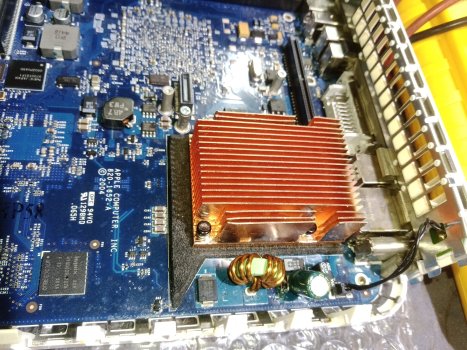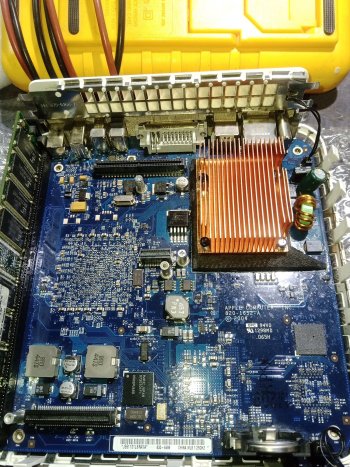Hello! This morning I decided to swap the CPU of a Mac Mini G4 1.25GHz that I had saved for testing.
Before removing it, I measured the CPU voltage on the capacitors next to it and with the tester it was 1.28V. I would have liked it to be a little more, but it wasn't enough.
My preheating equipment is a bit rudimentary, I won't go into details, but it works fine for now. I have removed the 7447A 1.25GHz and installed the 7447B 1.67GHz.
At 1.25GHz it works perfectly, and has passed the Geekbench test. The easiest speed to reach to start with was 1.92GHz, I just had to add a 1k resistor, before removing any pre-existing one, which would take a lot of work to put back.
I assembled everything, I pressed the button and..... "Chang!" was heard, and immediately afterwards the apple, the circle appeared and it arrived on the desk!!! It has booted to 1.92GHz, correct diagnosis and it recognizes it.
To assess the increase, I ran Geekbench, but here the problem appeared, the Mini freezes after 29-31 seconds of execution.
I think that 1.28V is not enough to keep 1.92GHz stable, and surely going down to 1.87GHz will stabilize it, but I always have time to do it.
I don't think anyone has documented it, from what you're telling me @
sailorMH, but how would it be possible to increase the voltage to 1.35v? which IC is responsible for it? Maybe there is a small IC near the capacitors, on the underside, but since it is BGA it is impossible to find out which resistors act on it.
Maybe @
dosdude1 , @
Jubadub or @
JoyBed can help me!!! Am I forgetting someone?
![quick150bus.png quick150bus.png]()




